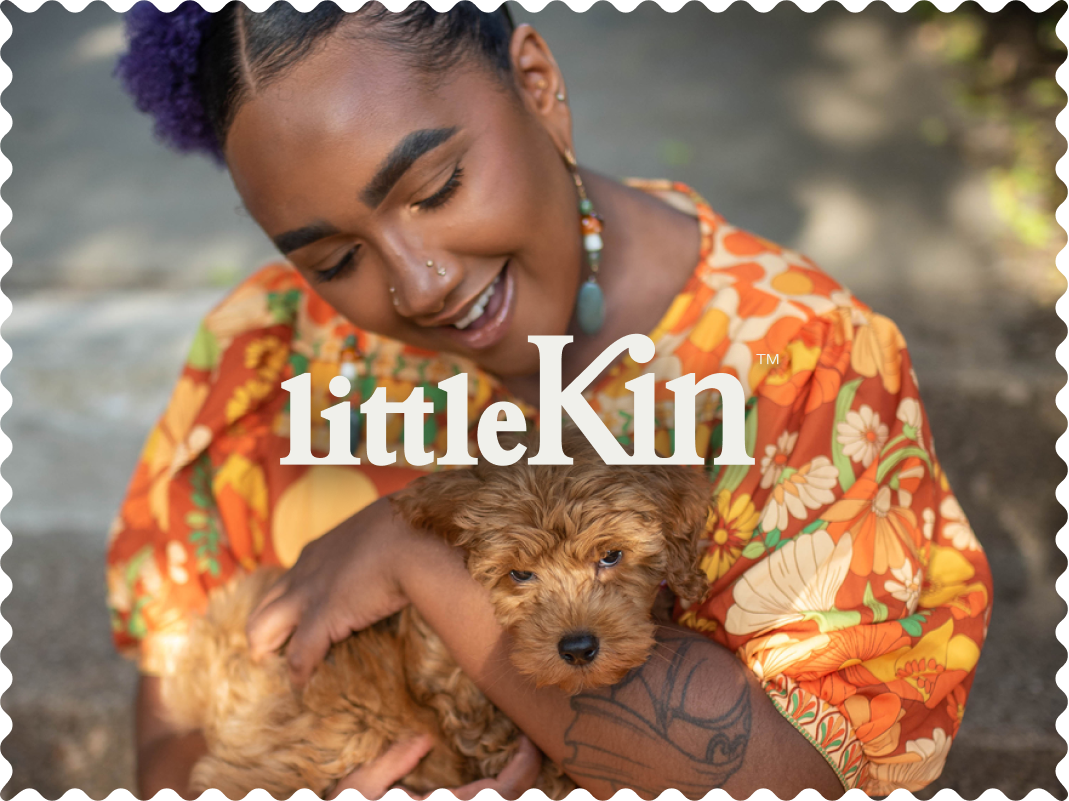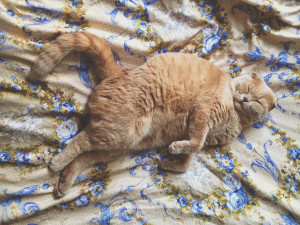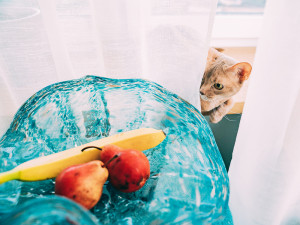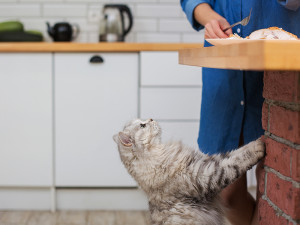Can Cats Eat Dog Biscuits?

Share Article
Dogs are often seen as the family pet that may go in search of something to scoff and can often be found with their head in the cat’s bowl. However, what if it’s your curious cat that’s interested in dog food? Is this safe and should we be trying to prevent them from eating dog biscuits? In this article, we explore why it is essential to feed a diet designed for your cat.
As a cat parent it is vital that we understand the basic nutritional requirements of our cats if we are to provide them with the correct diet to enable them to thriveopens in a new tab. Just like their wild ancestor, the North African wildcat, the domestic cat is a predatory species and is an obligate carnivore – which, in a nutshell, means they cannot be vegetarians and must eat a meat based diet to survive. Cats can eat dog biscuits occasionally, however, it’s not ideal.

littleKin™ is Kinship’s home just for puppy and kitten parents. Bop over to check out expert advice, new pet tools, and special deals—all curated for your newest family member.
opens in a new tabAre dog biscuits safe for cats?
Although dog biscuits are generally not toxic to catsopens in a new tab, they’re not the best choice for your feline, either. While a small nibble probably won’t harm your cat, regular consumption can lead to nutritional deficiencies as dog food lacks essential nutrients such as taurine, which cats need for heart and eye health. Additionally, some dog biscuits may contain ingredients that aren’t suitable for cats such as excess carbohydrates.
Why dog food is bad for cats long-term
Dog food is a ‘no no’ long-term as it lacks essential nutrients that cats need, so regular feeding can lead to health problems and nutritional deficiencies.
Taurine: cats require taurine which is an amino acid crucial for heart function, vision and digestion. Unlike their canine counterparts, cats cannot synthesise their own taurine, so it has to be provided in their food. A taurine deficiency can lead to heart disease (dilated cardiomyopathy) and vision problems.
Carbohydrates: cats struggle to digest carbohydratesopens in a new tab, something which can be found in high levels in dog food. Cats need a high-protein low-carb diet to stay fit and healthy.
Protein: dogs can survive on more plant-based proteins, whereas our feline friends need high amounts of animal protein. Long-term feeding of a diet lacking in enough protein for your cat could also lead to muscle loss and weakness.
Vitamin A & arachidonic acid: sadly, cats can’t synthesise vitamin A like dogs can, and the lack of this in dog food may lead to skin, coat and vision issues. The lack of arachidonic acid, an essential fatty acid, may also affect their kidneys, skin and reproductive health.
Difference between cat and dog food
Cats are carnivores and dogs are omnivores so their food differs primarily in nutritional content.opens in a new tab Cat food should always contain more animal-based protein whereas dog food often includes plant-based protein which cats can’t process efficiently.
The taurine in cat food is essential, however dogs can produce taurine on their own. Cats also need vitamin A and arachidonic acid so this is a priority ingredient. Cats don’t need as many carbohydrates as this may lead to weight gain and digestive issues. Cats need more fat for energy, so dog food lower in fat may not meet the dietary and nutitional requirements of cats.
Why do some cats like dog biscuits?
Let’s be honest – cats are opportunists. They can be extremely sneaky, so if they stumble across some dog biscuits on their travels, curiosity may get the better of them. The smell and crunchy texture of dog biscuits may appeal to some feline friends. Cats learn from observation so if their doggy housemate is tucking in to some biscuits they may want to explore what’s on offer. Cats could also be bored (lacking stimulation), dislike their own food or just be hungry and so might nibble on on some dog food if it is freely available.
How to stop your cat from eating dog food
If your inquisitive feline enjoys stealing dog biscuits, it’s vital that you ensure the food bowls are always lifted up if any contents are left. If you currently free feed your dog then maybe it’s time to start implimenting set meal times, so that you can separate or supervise your dog and cat’s meals. Think about the lay out of both pets’ eating areas, and whether you can elevate bowls or provide microchip activated feeders. You can use positive reinforcement to teach your cat to stay away from the dog’s bowl or redirect them with a toy to try and help break the habit.
Alternative biscuits to give your cat
There are plenty of cat treats on the market that may appeal to your cat to persuade them away from the dog bowl. Some treats are crunchy (fun to chew) and some are higher in protein, which can be very appealing and moreish.
Freeze-dried single ingredient treats are personally my go-to. Dental biscuits may also be a good choice as they will give them the crunchy texture whilst potentially helping with teeth hygiene. Being creative with treatsopens in a new tab – whether that’s by providing puzzle feeders, hiding them or getting your cat to chase the biscuits – can be fun and enticing for them. If cats receive a positive reward for their behaviour they are more likely to repeat it.
Final thoughts: can cats eat dog biscuits?
An occasional biscuit won’t hurt but feeding dog biscuits regularly can lead to serious health problems. It is best to stick to nutritionally balanced cat food to keep your feline happy and healthy.
Frequently asked questions: can cats eat dog food?
Can a cat eat dry dog food?
If your cat sneaks the odd piece of dry dog food, it is not usually harmful but it shouldn’t become a regular treat.
Are cat and dog biscuits the same?
No. They are formulated differently, so it is important that your cat receives species-specific pet food.
What human biscuits can cats eat?
Most humanopens in a new tab biscuits are not suitable for catsopens in a new tab as they may contain harmful ingredients such as salt and artificial sweeteners. A small piece of a plain, unsalted cracker such as a water cracker is OK from time-to-time.
Resources
Buffington, C. A. Tony. “ External and Internal Influences on Disease Risk in Cats.opens in a new tab” Journal of the American Veterinary Medical Association, vol. 220, no. 7, Apr. 2002, pp. 994–1002.
Buffington, CA Tony. “ Dry Foods and Risk of Disease in Cats.opens in a new tab” The Canadian Veterinary Journal, vol. 49, no. 6, June 2008, p. 561.
Morris, J. G., et al. “ Carbohydrate Digestion by the Domestic Cat (opens in a new tab” British Journal of Nutrition, vol. 37, no. 3, May 1977, pp. 365–73.
Morris, James G., and Quinton R. Rogers. “ Arginine: An Essential Amino Acid for the Cat.opens in a new tab” The Journal of Nutrition, vol. 108, no. 12, Dec. 1978, pp. 1944–53.
Thiess, S., et al. “ Effects of High Carbohydrate and High Fat Diet on Plasma Metabolite Levels and on Iv Glucose Tolerance Test in Intact and Neutered Male Cats.opens in a new tab” Journal of Feline Medicine and Surgery, vol. 6, no. 4, Aug. 2004, pp. 207–18.
Tranter MA VetMB CertAVP MRCVS, Sian. “ Can Cats Eat Dog Food, Because It’s Cheaper?opens in a new tab” Vet Help Direct, 17 Dec. 2020.
Verbrugghe, Adronie, and Myriam Hesta. “ Cats and Carbohydrates: The Carnivore Fantasy?opens in a new tab” Veterinary Sciences, vol. 4, no. 4, Nov. 2017, p. 55.
Zaghini, G., and G. Biagi. “ Nutritional Peculiarities and Diet Palatability in the Cat.opens in a new tab” Veterinary Research Communications, vol. 29, no. S2, Aug. 2005, pp. 39–44.

Zoe Blake RVN, ISFMCertFN / AdvCertFB, MISAP
Zoe is a registered veterinary nurse and has been in the profession for over 30 years. She enjoys educating pet owners on all aspects of their care and regularly writes to support her work. When she is not chatting animals, she can be found running around the tennis court or exploring the countryside with her rescue dog, Dylan.
Related articles
![overweight orange cat]() opens in a new tab
opens in a new tabHow Much Should You Actually Be Feeding Your Cat?
If they’ve lost their hourglass figure, then not that much – according to a veterinary nutritionist
![Cat behind a curtain attempting to get fruit in blue bowl]() opens in a new tab
opens in a new tabWhat Fruits Can Your Cat Feast On?
Pass the fruit bowl – it’s treat time
![Profile view of a man giving a cat food to eat]() opens in a new tab
opens in a new tabWhy Is My New Cat Not Eating?
A veterinary nutritionist explains the causes, signs and treatment for how to increase their appetite
![Cat asking for human food from counter]() opens in a new tab
opens in a new tab10 Human Foods That Are Safe for Cats
Good news for your begging cat: some of your favourite snacks are safe to share



